Error analysis on english compositions and paragraphs of Vietnamese students
The present study aimed to explore the writing errors in English compositions and paragraphs of
Vietnamese students at a university in Vietnam and to compare the shared common errors made in
their writings. This intended to see whether students with different levels have the same errors.
The study used a corpus of 36 Vietnamese students’ composition writings and 36 paragraph
writings. The data committed were categorized into three different error types by the framework of
Chanquoy (2001). The results showed that the three most frequent writing errors were spelling,
subject-verb agreement, verb tense and form respectively in paragraphs and compositions. Results
revealed the three most shared errors involved spelling, subject-verb agreement and verb tense and
form; nevertheless, there is no significant difference between the number of errors. It is suggested
that intensive knowledge of language teaching in vocabulary in spelling and English grammar,
especially subject-verb agreement should be paid close attention. In light of the results obtained,
implications and recommendations were provided to teachers to assist their students in writing and
limit common errors among Vietnamese students.
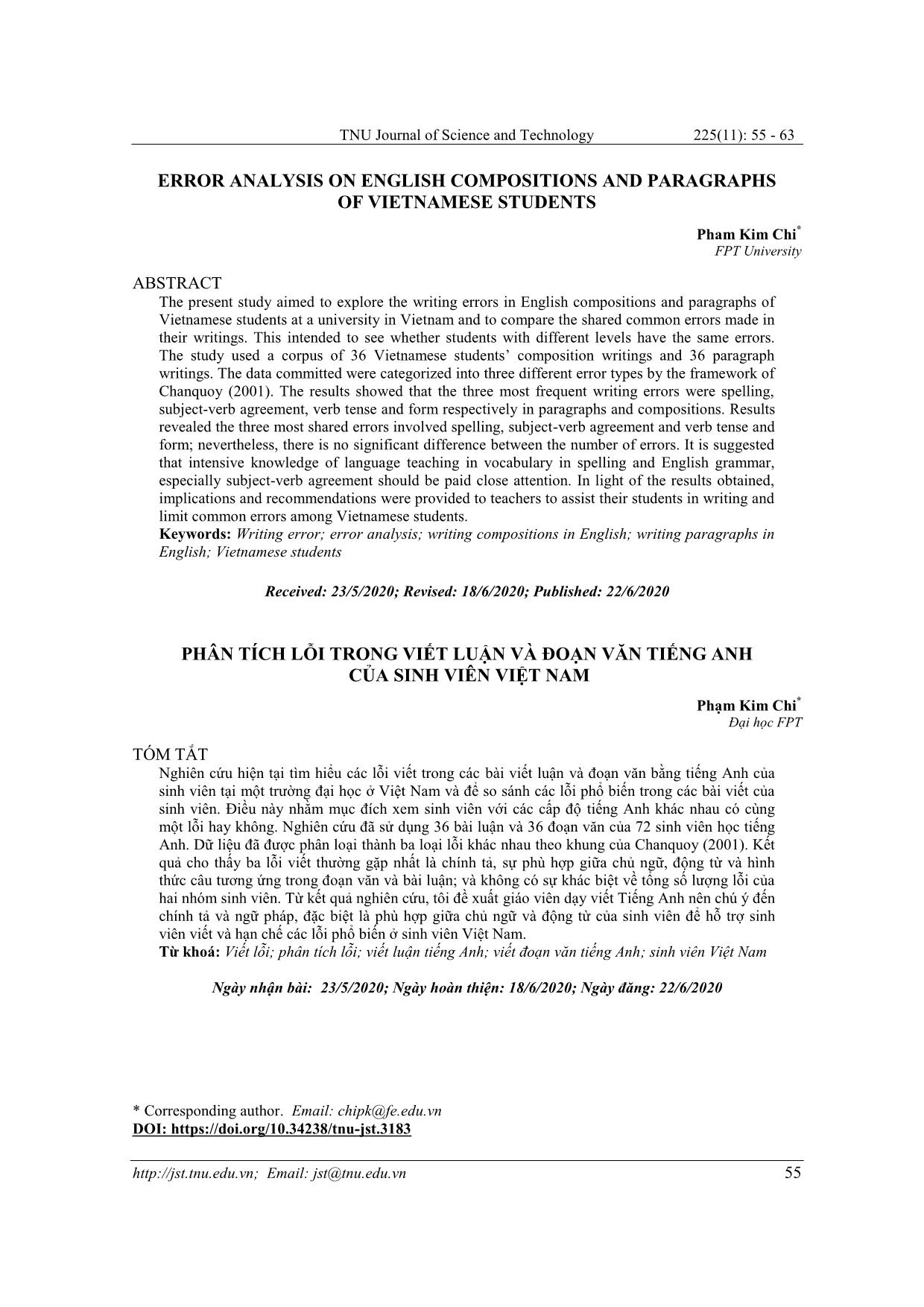
Trang 1
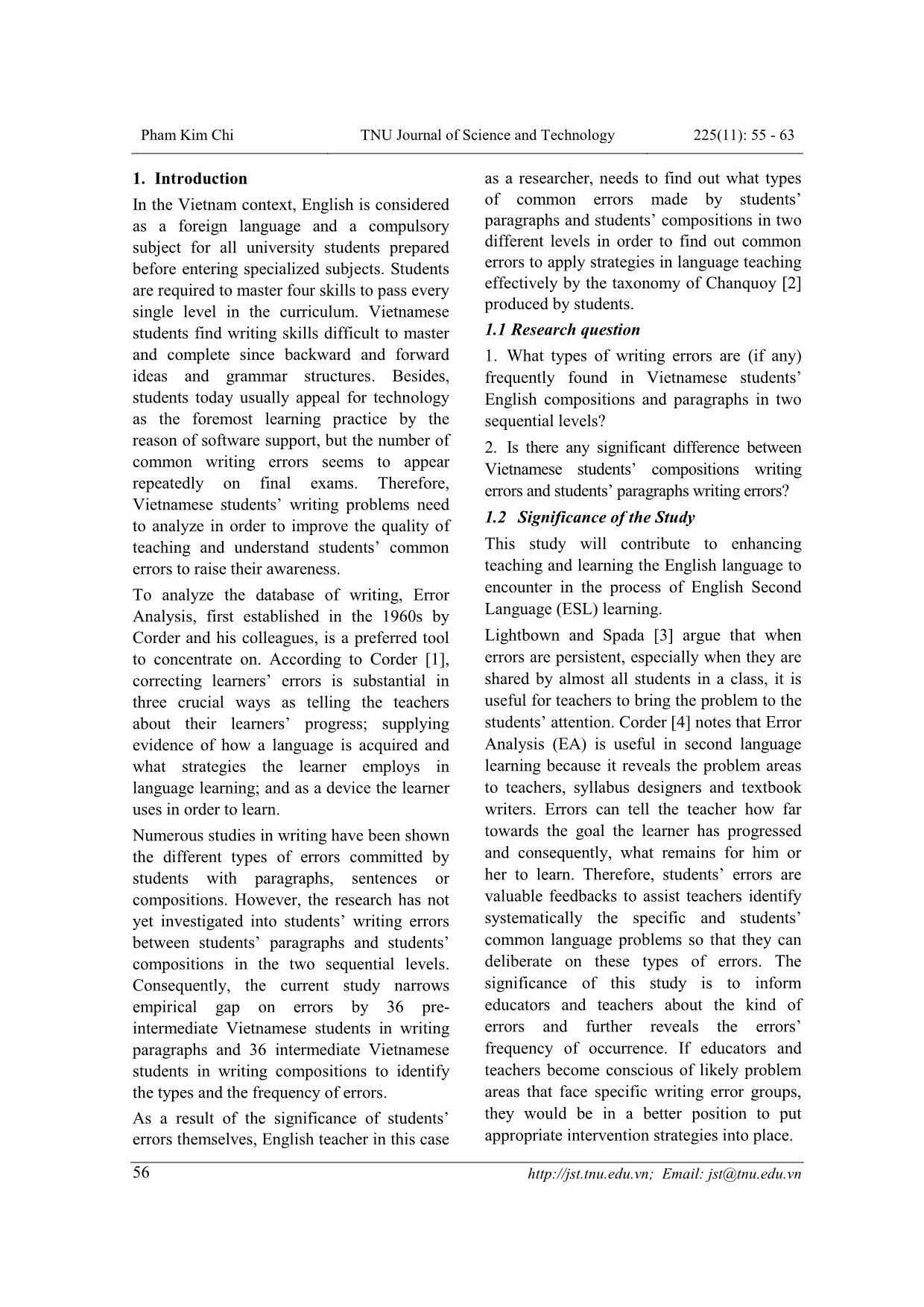
Trang 2
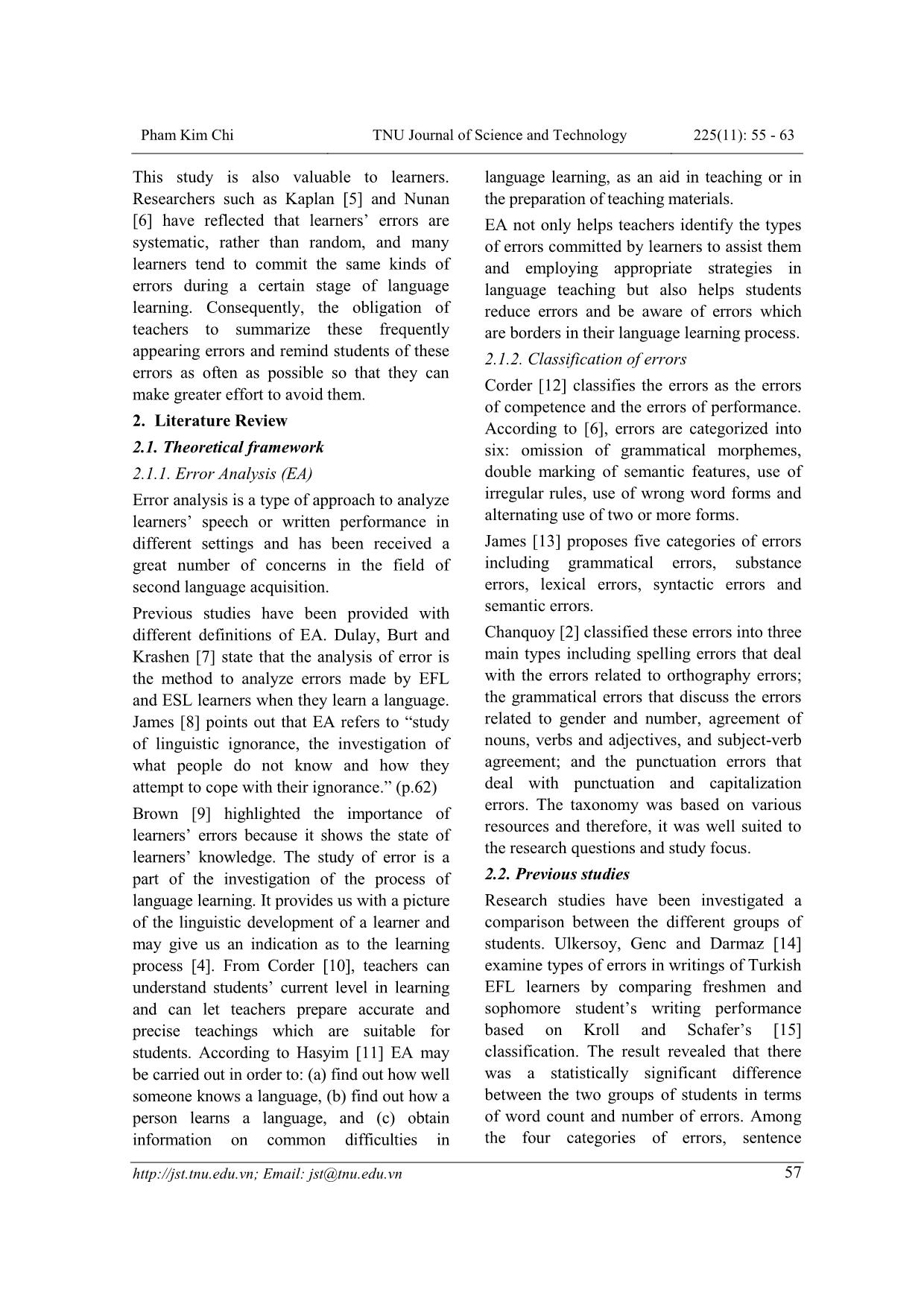
Trang 3
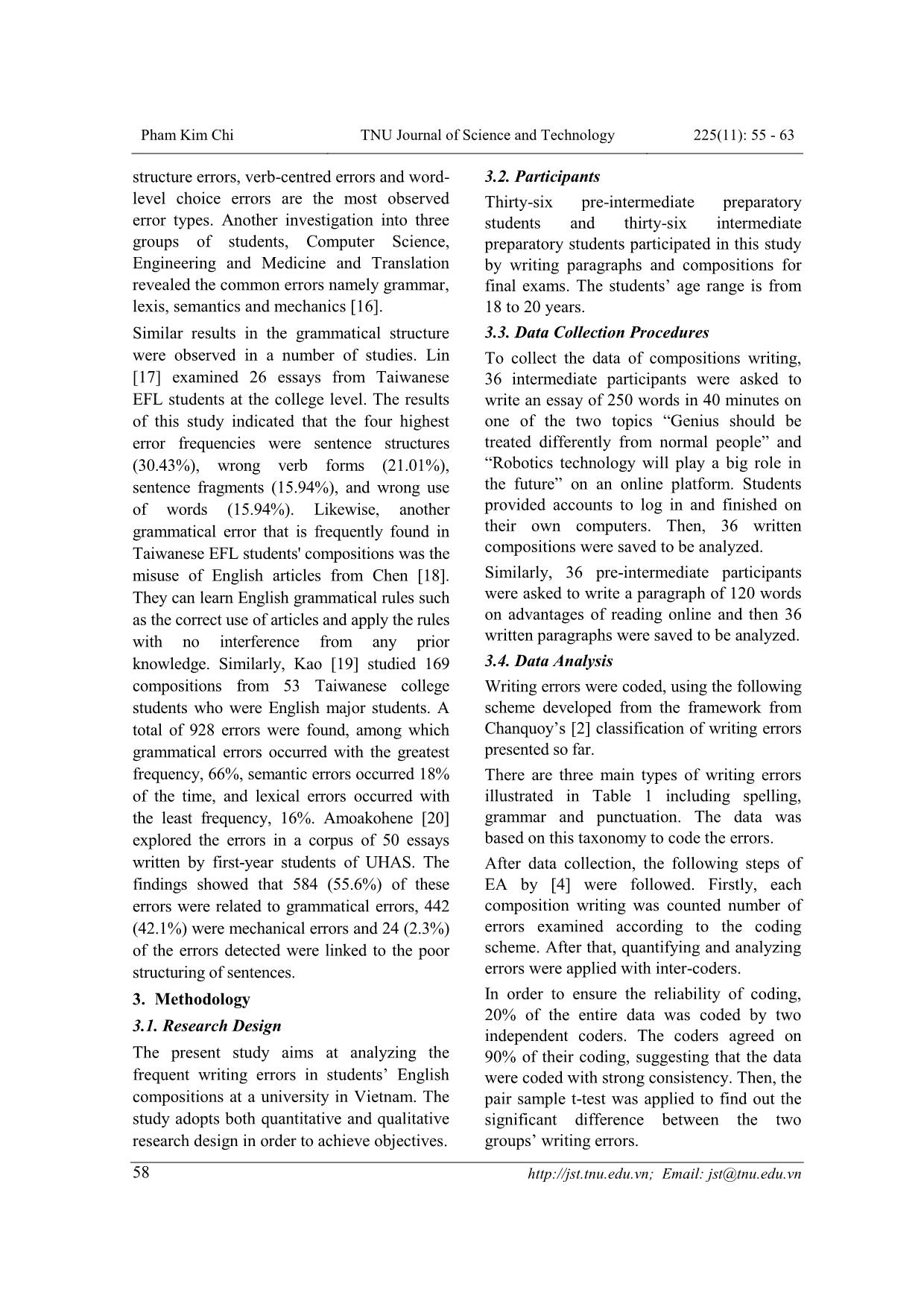
Trang 4
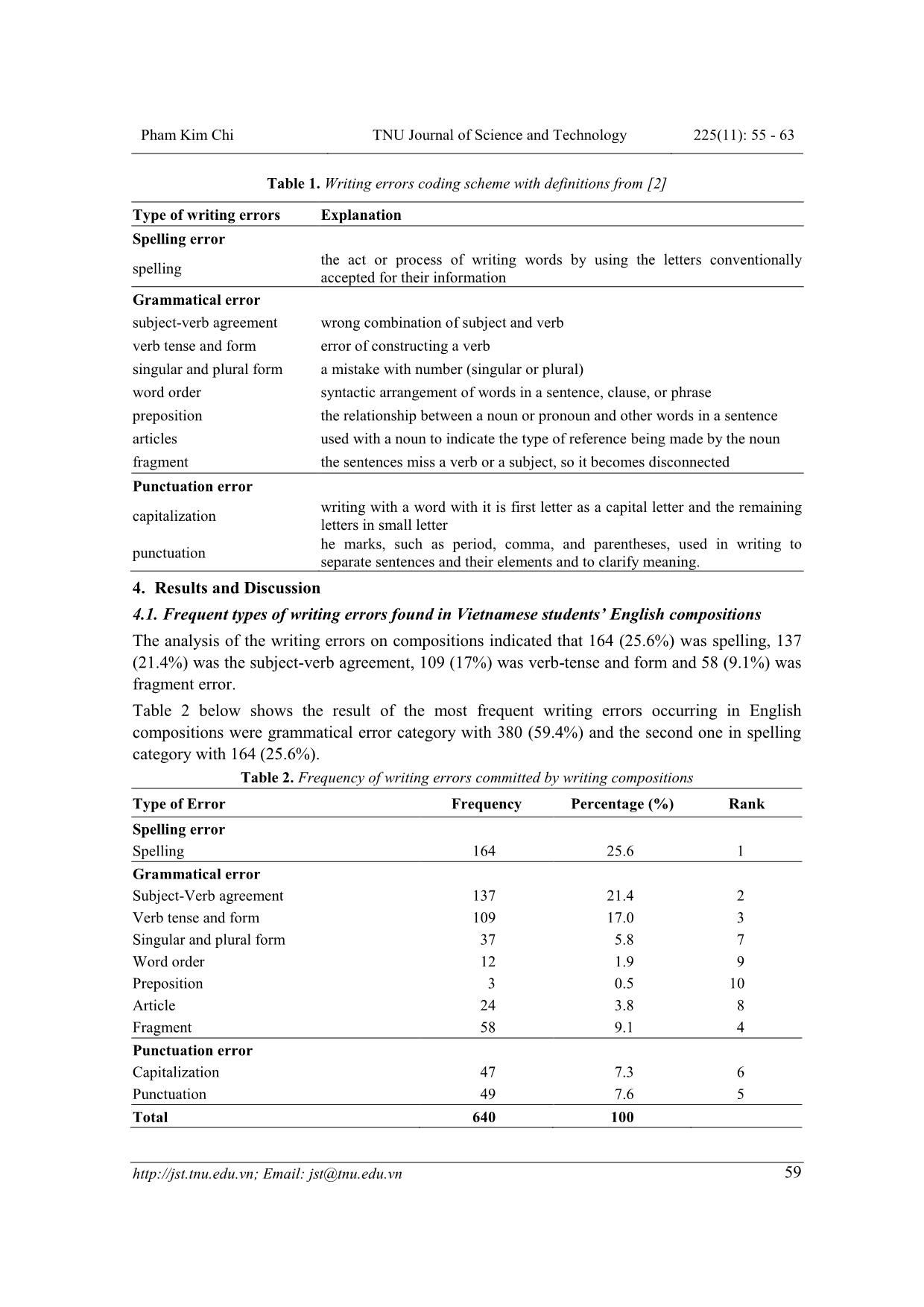
Trang 5
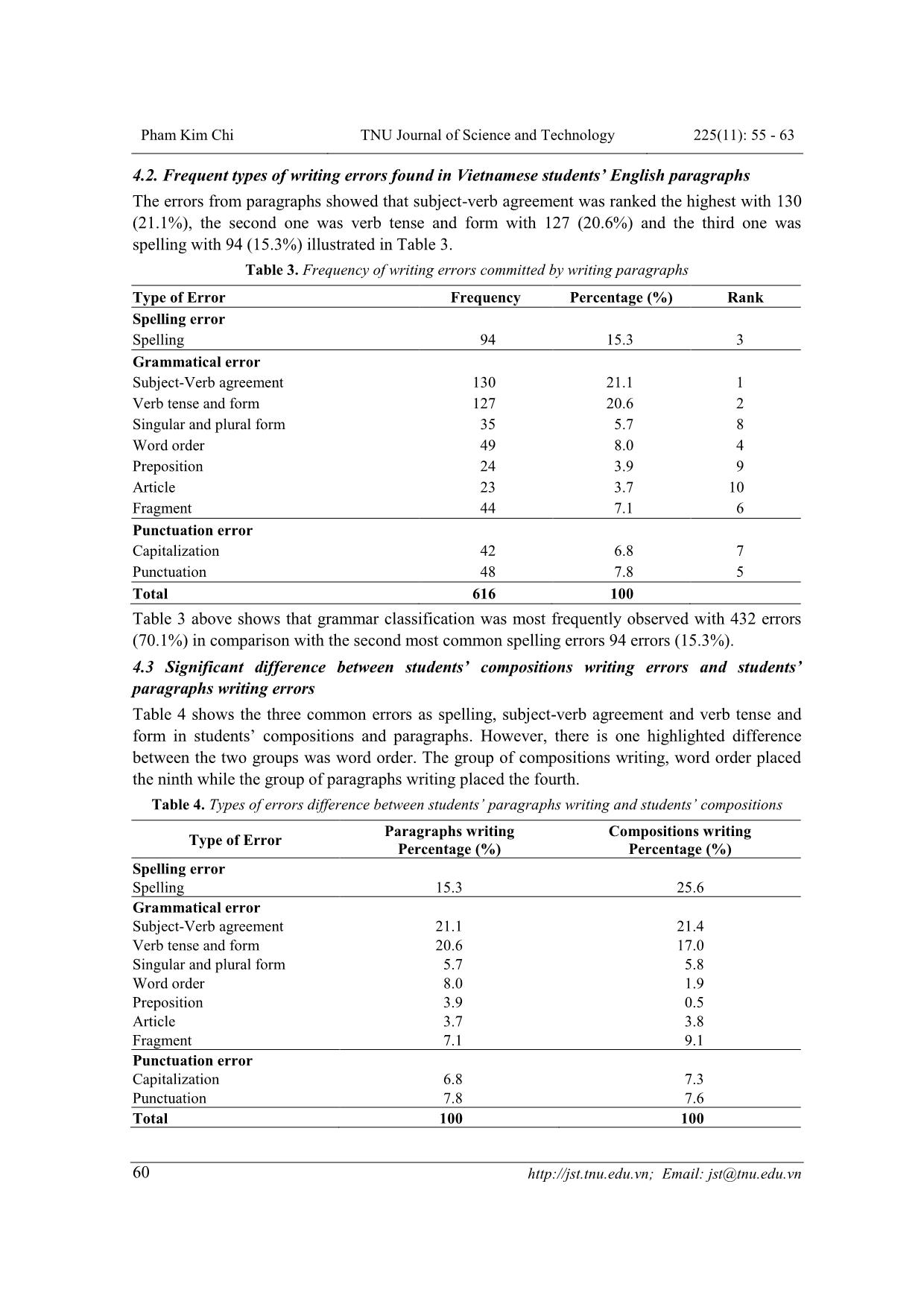
Trang 6
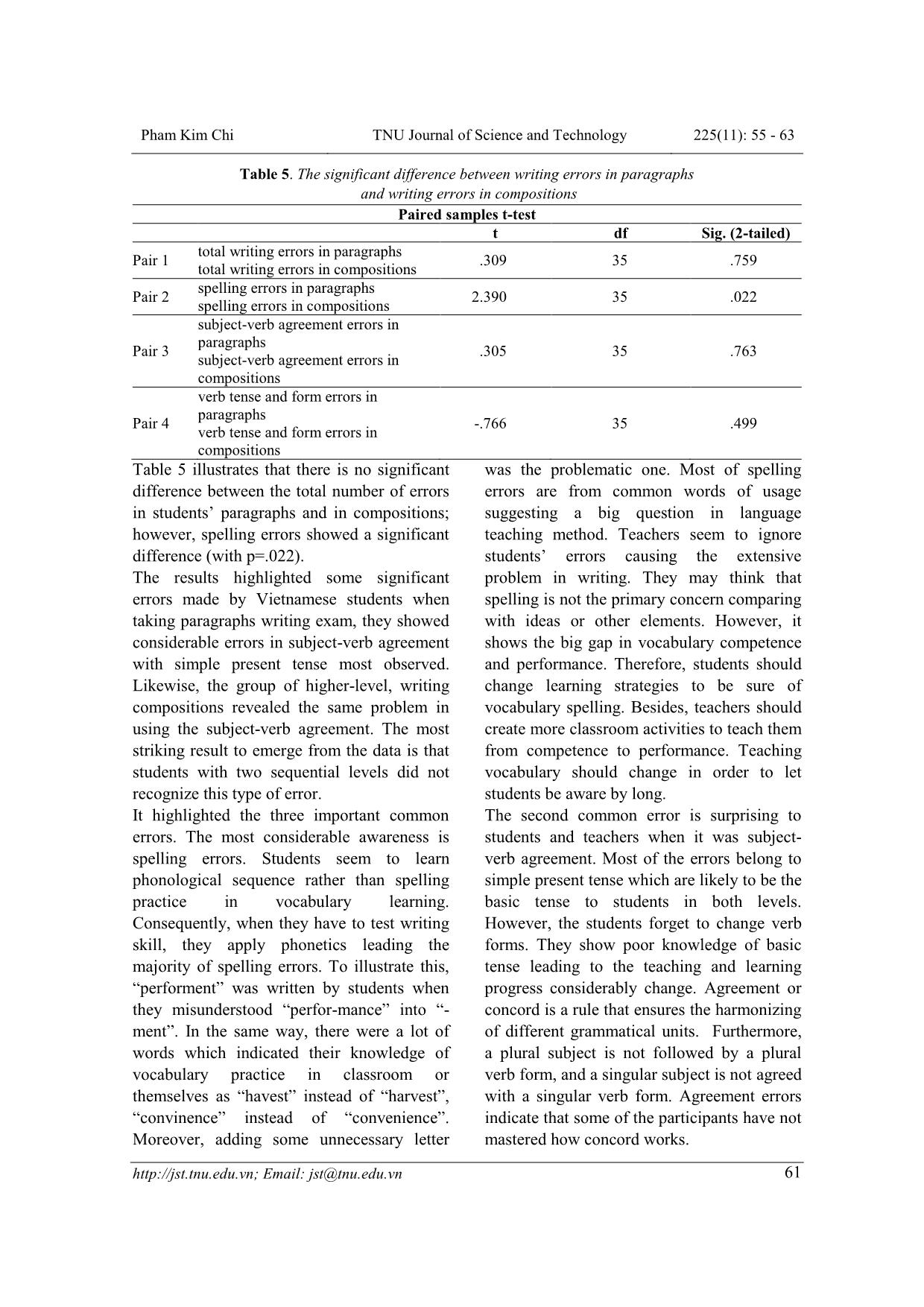
Trang 7
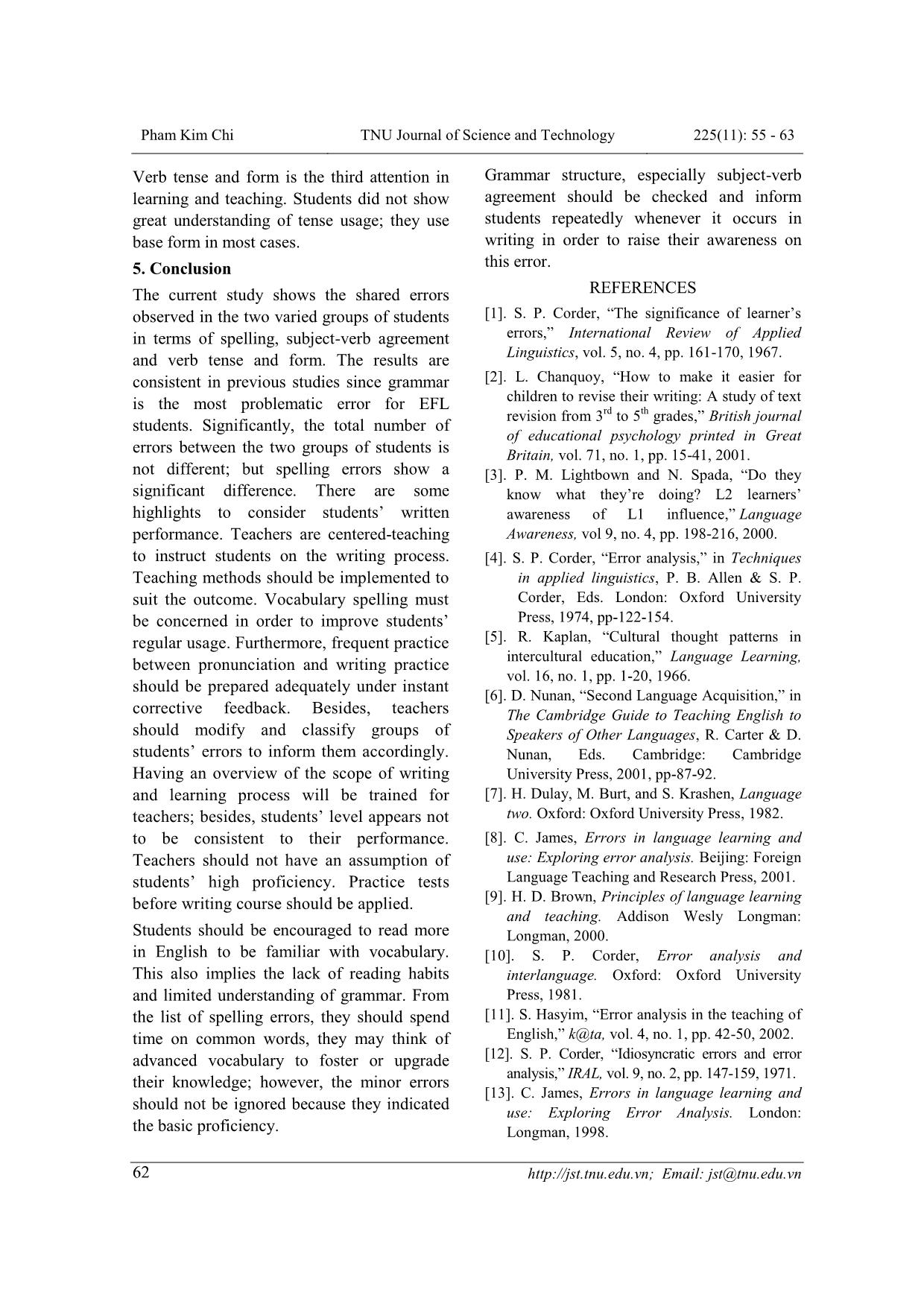
Trang 8
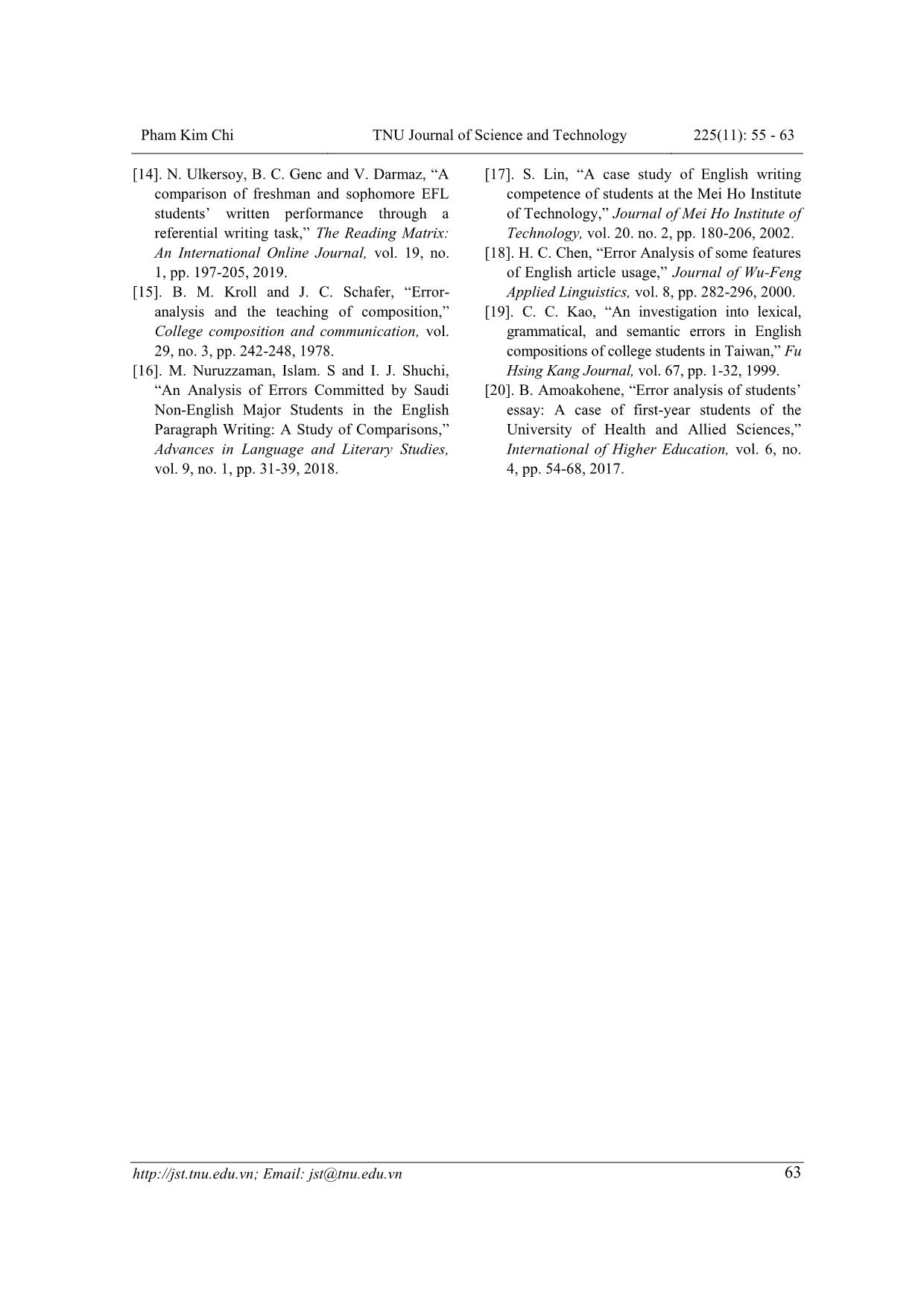
Trang 9
Tóm tắt nội dung tài liệu: Error analysis on english compositions and paragraphs of Vietnamese students
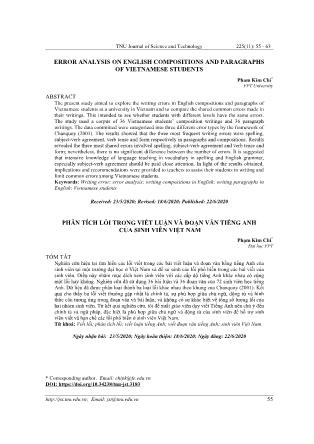
TNU Journal of Science and Technology 225(11): 55 - 63 Email: jst@tnu.edu.vn 55 ERROR ANALYSIS ON ENGLISH COMPOSITIONS AND PARAGRAPHS OF VIETNAMESE STUDENTS Pham Kim Chi * FPT University ABSTRACT The present study aimed to explore the writing errors in English compositions and paragraphs of Vietnamese students at a university in Vietnam and to compare the shared common errors made in their writings. This intended to see whether students with different levels have the same errors. The study used a corpus of 36 Vietnamese students’ composition writings and 36 paragraph writings. The data committed were categorized into three different error types by the framework of Chanquoy (2001). The results showed that the three most frequent writing errors were spelling, subject-verb agreement, verb tense and form respectively in paragraphs and compositions. Results revealed the three most shared errors involved spelling, subject-verb agreement and verb tense and form; nevertheless, there is no significant difference between the number of errors. It is suggested that intensive knowledge of language teaching in vocabulary in spelling and English grammar, especially subject-verb agreement should be paid close attention. In light of the results obtained, implications and recommendations were provided to teachers to assist their students in writing and limit common errors among Vietnamese students. Keywords: Writing error; error analysis; writing compositions in English; writing paragraphs in English; Vietnamese students Received: 23/5/2020; Revised: 18/6/2020; Published: 22/6/2020 PHÂN TÍCH LỖI TRONG VIẾT LUẬN VÀ ĐOẠN VĂN TIẾNG ANH CỦA SINH VIÊN VIỆT NAM Phạm Kim Chi* Đại học FPT TÓM TẮT Nghiên cứu hiện tại tìm hiểu các lỗi viết trong các bài viết luận và đoạn văn bằng tiếng Anh của sinh viên tại một trường đại học ở Việt Nam và để so sánh các lỗi phổ biến trong các bài viết của sinh viên. Điều này nhằm mục đích xem sinh viên với các cấp độ tiếng Anh khác nhau có cùng một lỗi hay không. Nghiên cứu đã sử dụng 36 bài luận và 36 đoạn văn của 72 sinh viên học tiếng Anh. Dữ liệu đã được phân loại thành ba loại lỗi khác nhau theo khung của Chanquoy (2001). Kết quả cho thấy ba lỗi viết thường gặp nhất là chính tả, sự phù hợp giữa chủ ngữ, động từ và hình thức câu tương ứng trong đoạn văn và bài luận; và không có sự khác biệt về tổng số lượng lỗi của hai nhóm sinh viên. Từ kết quả nghiên cứu, tôi đề xuất giáo viên dạy viết Tiếng Anh nên chú ý đến chính tả và ngữ pháp, đặc biệt là phù hợp giữa chủ ngữ và động từ của sinh viên để hỗ trợ sinh viên viết và hạn chế các lỗi phổ biến ở sinh viên Việt Nam. Từ khoá: Viết lỗi; phân tích lỗi; viết luận tiếng Anh; viết đoạn văn tiếng Anh; sinh viên Việt Nam Ngày nhận bài: 23/5/2020; Ngày hoàn thiện: 18/6/2020; Ngày đăng: 22/6/2020 * Corresponding author. Email: chipk@fe.edu.vn DOI: https://doi.org/10.34238/tnu-jst.3183 Pham Kim Chi TNU Journal of Science and Technology 225(11): 55 - 63 Email: jst@tnu.edu.vn 56 1. Introduction In the Vietnam context, English is considered as a foreign language and a compulsory subject for all university students prepared before entering specialized subjects. Students are required to master four skills to pass every single level in the curriculum. Vietnamese students find writing skills difficult to master and complete since backward and forward ideas and grammar structures. Besides, students today usually appeal for technology as the foremost learning practice by the reason of software support, but the number of common writing errors seems to appear repeatedly on final exams. Therefore, Vietnamese students’ writing problems need to analyze in order to improve the quality of teaching and understand students’ common errors to raise their awareness. To analyze the database of writing, Error Analysis, first established in the 1960s by Corder and his colleagues, is a preferred tool to concentrate on. According to Corder [1], correcting learners’ errors is substantial in three crucial ways as telling the teachers about their learners’ progress; supplying evidence of how a language is acquired and what strategies the learner employs in language learning; and as a device the learner uses in order to learn. Numerous studies in writing have been shown the different types of errors committed by students with paragraphs, sentences or compositions. However, the research has not yet investigated into students’ writing errors between students’ paragraphs and students’ compositions in the two sequential levels. Consequently, the current study narrows empirical gap on errors by 36 pre- intermediate Vietnamese students in writing paragraphs and 36 intermediate Vietnamese students in writing compositions to identify the types and the frequency of errors. As a result of the significance of students’ errors themselves, English teacher in this case as a researcher, needs to find out what types of common errors made by students’ paragraphs and students’ compositions in two different levels in order to find out common errors to apply strategies in language teaching effectively by the taxonomy of Chanquoy [2] produced by students. 1.1 Research question 1. What types of writing errors are (if any) frequently found in Vietnamese students’ English compositions and paragraphs in two sequential levels? 2. Is there any significant difference between Vietnamese students’ compositions writing errors and students’ paragraphs writing errors? 1.2 Significance of the Study This study will contribute to enhancing teaching and learning the English language to encounter in the process of English Second Language (ESL) learning. Lightbown and Spada [3] argue that when errors are persistent, especially when they are shared by almost all students in a class, it i ... e data was based on this taxonomy to code the errors. After data collection, the following steps of EA by [4] were followed. Firstly, each composition writing was counted number of errors examined according to the coding scheme. After that, quantifying and analyzing errors were applied with inter-coders. In order to ensure the reliability of coding, 20% of the entire data was coded by two independent coders. The coders agreed on 90% of their coding, suggesting that the data were coded with strong consistency. Then, the pair sample t-test was applied to find out the significant difference between the two groups’ writing errors. Pham Kim Chi TNU Journal of Science and Technology 225(11): 55 - 63 Email: jst@tnu.edu.vn 59 Table 1. Writing errors coding scheme with definitions from [2] Type of writing errors Explanation Spelling error spelling the act or process of writing words by using the letters conventionally accepted for their information Grammatical error subject-verb agreement wrong combination of subject and verb verb tense and form error of constructing a verb singular and plural form a mistake with number (singular or plural) word order syntactic arrangement of words in a sentence, clause, or phrase preposition the relationship between a noun or pronoun and other words in a sentence articles used with a noun to indicate the type of reference being made by the noun fragment the sentences miss a verb or a subject, so it becomes disconnected Punctuation error capitalization writing with a word with it is first letter as a capital letter and the remaining letters in small letter punctuation he marks, such as period, comma, and parentheses, used in writing to separate sentences and their elements and to clarify meaning. 4. Results and Discussion 4.1. Frequent types of writing errors found in Vietnamese students’ English compositions The analysis of the writing errors on compositions indicated that 164 (25.6%) was spelling, 137 (21.4%) was the subject-verb agreement, 109 (17%) was verb-tense and form and 58 (9.1%) was fragment error. Table 2 below shows the result of the most frequent writing errors occurring in English compositions were grammatical error category with 380 (59.4%) and the second one in spelling category with 164 (25.6%). Table 2. Frequency of writing errors committed by writing compositions Type of Error Frequency Percentage (%) Rank Spelling error Spelling 164 25.6 1 Grammatical error Subject-Verb agreement 137 21.4 2 Verb tense and form 109 17.0 3 Singular and plural form 37 5.8 7 Word order 12 1.9 9 Preposition 3 0.5 10 Article 24 3.8 8 Fragment 58 9.1 4 Punctuation error Capitalization 47 7.3 6 Punctuation 49 7.6 5 Total 640 100 Pham Kim Chi TNU Journal of Science and Technology 225(11): 55 - 63 Email: jst@tnu.edu.vn 60 4.2. Frequent types of writing errors found in Vietnamese students’ English paragraphs The errors from paragraphs showed that subject-verb agreement was ranked the highest with 130 (21.1%), the second one was verb tense and form with 127 (20.6%) and the third one was spelling with 94 (15.3%) illustrated in Table 3. Table 3. Frequency of writing errors committed by writing paragraphs Type of Error Frequency Percentage (%) Rank Spelling error Spelling 94 15.3 3 Grammatical error Subject-Verb agreement 130 21.1 1 Verb tense and form 127 20.6 2 Singular and plural form 35 5.7 8 Word order 49 8.0 4 Preposition 24 3.9 9 Article 23 3.7 10 Fragment 44 7.1 6 Punctuation error Capitalization 42 6.8 7 Punctuation 48 7.8 5 Total 616 100 Table 3 above shows that grammar classification was most frequently observed with 432 errors (70.1%) in comparison with the second most common spelling errors 94 errors (15.3%). 4.3 Significant difference between students’ compositions writing errors and students’ paragraphs writing errors Table 4 shows the three common errors as spelling, subject-verb agreement and verb tense and form in students’ compositions and paragraphs. However, there is one highlighted difference between the two groups was word order. The group of compositions writing, word order placed the ninth while the group of paragraphs writing placed the fourth. Table 4. Types of errors difference between students’ paragraphs writing and students’ compositions Type of Error Paragraphs writing Percentage (%) Compositions writing Percentage (%) Spelling error Spelling 15.3 25.6 Grammatical error Subject-Verb agreement 21.1 21.4 Verb tense and form 20.6 17.0 Singular and plural form 5.7 5.8 Word order 8.0 1.9 Preposition 3.9 0.5 Article 3.7 3.8 Fragment 7.1 9.1 Punctuation error Capitalization 6.8 7.3 Punctuation 7.8 7.6 Total 100 100 Pham Kim Chi TNU Journal of Science and Technology Email: jst@tnu.edu.vn 61 Table 5. The significant difference between writing errors in paragraphs and writing errors in compositions Paired samples t-test t df Pair 1 total writing errors in paragraphs total writing errors in compositions .309 35 Pair 2 spelling errors in paragraphs spelling errors in compositions 2.390 35 Pair 3 subject-verb agreement errors in paragraphs subject-verb agreement errors in compositions .305 35 Pair 4 verb tense and form errors in paragraphs verb tense and form errors in compositions -.766 35 225(11): 55 - 63 Sig. (2-tailed) .759 .022 .763 .499 Table 5 illustrates that there is no significant difference between the total number of errors in students’ paragraphs and in compositions; however, spelling errors showed a significant difference (with p=.022). The results highlighted some significant errors made by Vietnamese students when taking paragraphs writing exam, they showed considerable errors in subject-verb agreement with simple present tense most observed. Likewise, the group of higher-level, writing compositions revealed the same problem in using the subject-verb agreement. The most striking result to emerge from the data is that students with two sequential levels did not recognize this type of error. It highlighted the three important common errors. The most considerable awareness is spelling errors. Students seem to learn phonological sequence rather than spelling practice in vocabulary learning. Consequently, when they have to test writing skill, they apply phonetics leading the majority of spelling errors. To illustrate this, “performent” was written by students when they misunderstood “perfor-mance” into “- ment”. In the same way, there were a lot of words which indicated their knowledge of vocabulary practice in classroom or themselves as “havest” instead of “harvest”, “convinence” instead of “convenience”. Moreover, adding some unnecessary letter was the problematic one. Most of spelling errors are from common words of usage suggesting a big question in language teaching method. Teachers seem to ignore students’ errors causing the extensive problem in writing. They may think that spelling is not the primary concern comparing with ideas or other elements. However, it shows the big gap in vocabulary competence and performance. Therefore, students should change learning strategies to be sure of vocabulary spelling. Besides, teachers should create more classroom activities to teach them from competence to performance. Teaching vocabulary should change in order to let students be aware by long. The second common error is surprising to students and teachers when it was subject- verb agreement. Most of the errors belong to simple present tense which are likely to be the basic tense to students in both levels. However, the students forget to change verb forms. They show poor knowledge of basic tense leading to the teaching and learning progress considerably change. Agreement or concord is a rule that ensures the harmonizing of different grammatical units. Furthermore, a plural subject is not followed by a plural verb form, and a singular subject is not agreed with a singular verb form. Agreement errors indicate that some of the participants have not mastered how concord works. Pham Kim Chi TNU Journal of Science and Technology Email: jst@tnu.edu.vn 62 Verb tense and form is the third attention in learning and teaching. Students did not show great understanding of tense usage; they use base form in most cases. 5. Conclusion The current study shows the shared errors observed in the two varied groups of students in terms of spelling, subject-verb agreement and verb tense and form. The results are consistent in previous studies since grammar is the most problematic error for EFL students. Significantly, the total number of errors between the two groups of students is not different; but spelling errors show a significant difference. There are some highlights to consider students’ written performance. Teachers are centered-teaching to instruct students on the writing process. Teaching methods should be implemented to suit the outcome. Vocabulary spelling must be concerned in order to improve students’ regular usage. Furthermore, frequent practice between pronunciation and writing practice should be prepared adequately under instant corrective feedback. Besides, teachers should modify and classify groups of students’ errors to inform them accordingly. Having an overview of the scope of writing and learning process will be trained for teachers; besides, students’ level appears not to be consistent to their performance. Teachers should not have an assumption of students’ high proficiency. Practice tests before writing course should be applied. Students should be encouraged to read more in English to be familiar with vocabulary. This also implies the lack of reading habits and limited understanding of grammar. From the list of spelling errors, they should spend time on common words, they may think of advanced vocabulary to foster or upgrade their knowledge; however, the minor errors should not be ignored because they indicated the basic proficiency. 225(11): 55 - 63 Grammar structure, especially subject-verb agreement should be checked and inform students repeatedly whenever it occurs in writing in order to raise their awareness on this error. REFERENCES [1]. S. P. Corder, “The significance of learner’s errors,” International Review of Applied Linguistics, vol. 5, no. 4, pp. 161-170, 1967. [2]. L. Chanquoy, “How to make it easier for children to revise their writing: A study of text revision from 3 rd to 5 th grades,” British journal of educational psychology printed in Great Britain, vol. 71, no. 1, pp. 15-41, 2001. [3]. P. M. Lightbown and N. Spada, “Do they know what they’re doing? L2 learners’ awareness of L1 influence,” Language Awareness, vol 9, no. 4, pp. 198-216, 2000. [4]. S. P. Corder, “Error analysis,” in Techniques in applied linguistics, P. B. Allen & S. P. Corder, Eds. London: Oxford University Press, 1974, pp-122-154. [5]. R. Kaplan, “Cultural thought patterns in intercultural education,” Language Learning, vol. 16, no. 1, pp. 1-20, 1966. [6]. D. Nunan, “Second Language Acquisition,” in The Cambridge Guide to Teaching English to Speakers of Other Languages, R. Carter & D. Nunan, Eds. Cambridge: Cambridge University Press, 2001, pp-87-92. [7]. H. Dulay, M. Burt, and S. Krashen, Language two. Oxford: Oxford University Press, 1982. [8]. C. James, Errors in language learning and use: Exploring error analysis. Beijing: Foreign Language Teaching and Research Press, 2001. [9]. H. D. Brown, Principles of language learning and teaching. Addison Wesly Longman: Longman, 2000. [10]. S. P. Corder, Error analysis and interlanguage. Oxford: Oxford University Press, 1981. [11]. S. Hasyim, “Error analysis in the teaching of English,” k@ta, vol. 4, no. 1, pp. 42-50, 2002. [12]. S. P. Corder, “Idiosyncratic errors and error analysis,” IRAL, vol. 9, no. 2, pp. 147-159, 1971. [13]. C. James, Errors in language learning and use: Exploring Error Analysis. London: Longman, 1998. Pham Kim Chi TNU Journal of Science and Technology Email: jst@tnu.edu.vn 63 [14]. N. Ulkersoy, B. C. Genc and V. Darmaz, “A comparison of freshman and sophomore EFL students’ written performance through a referential writing task,” The Reading Matrix: An International Online Journal, vol. 19, no. 1, pp. 197-205, 2019. [15]. B. M. Kroll and J. C. Schafer, “Error- analysis and the teaching of composition,” College composition and communication, vol. 29, no. 3, pp. 242-248, 1978. [16]. M. Nuruzzaman, Islam. S and I. J. Shuchi, “An Analysis of Errors Committed by Saudi Non-English Major Students in the English Paragraph Writing: A Study of Comparisons,” Advances in Language and Literary Studies, vol. 9, no. 1, pp. 31-39, 2018. 225(11): 55 - 63 [17]. S. Lin, “A case study of English writing competence of students at the Mei Ho Institute of Technology,” Journal of Mei Ho Institute of Technology, vol. 20. no. 2, pp. 180-206, 2002. [18]. H. C. Chen, “Error Analysis of some features of English article usage,” Journal of Wu-Feng Applied Linguistics, vol. 8, pp. 282-296, 2000. [19]. C. C. Kao, “An investigation into lexical, grammatical, and semantic errors in English compositions of college students in Taiwan,” Fu Hsing Kang Journal, vol. 67, pp. 1-32, 1999. [20]. B. Amoakohene, “Error analysis of students’ essay: A case of first-year students of the University of Health and Allied Sciences,” International of Higher Education, vol. 6, no. 4, pp. 54-68, 2017.
File đính kèm:
 error_analysis_on_english_compositions_and_paragraphs_of_vie.pdf
error_analysis_on_english_compositions_and_paragraphs_of_vie.pdf

